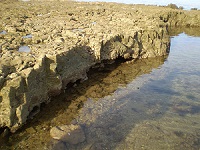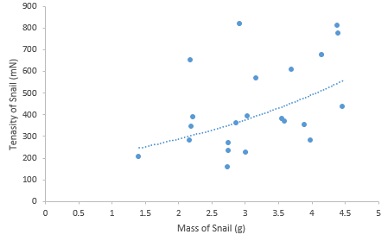Muscular Foot Tenacity:
Considered to be one of the harshest environment on the planet, the rocky inter-tidal zones are the connections between the marine and terrestrial worlds (Helmuth et all, 2005). Organisms which inhabit these areas are remarkably adapted to a life with fluctuation in water height, variations in temperature, air, water availability and UV levels. Another factor which increases the threat of this life on the edge is hydrodynamic forces which are generated via wave action. However key adaptions have evolved to counteract arguably the most dominant force acting on the rocky inter-tidal zone.
Gastropods locomotion and attachment to substrate is provided by a single appendage, the muscular foot (Denny, 1980).With the use of mucus constructed of water, dissolved salts and glycoprotein the Gastropod is able to adhere to substrates. Due to this pulling the shell down firmly onto the substrate, attached by its foot Gastropods are able to use the shell for protection on the wave swept rocks (Gäde, 1988). This protection provided by the shell is essential for the survival of Gastropods, especially members of the Trochidae family as once dislodged from the substrate they become vulnerable to predation as they often lie upside down (Gäde,1988).
This important structural function in Gastropods lead to the study which aimed to investigate the effect of shell mass on the attachment strength of Austrocochlea Constricta. It was hypothesized that increasing shell mass would correlate with greater attachment strength, this would be shown by an increase in force required to dislodge an organism from the substrate.
On an afternoon low tide at Woody Point, Southeast Queensland, 22 individuals of Austrocochlea Constricta were collected from a rock platform. Specimens were placed in a large container which included seawater and substrate, which was then transported to the laboratory by vehicle.
 Figure 1: Assortment of Photographs from Collection Area at Woody Point
Figure 1: Assortment of Photographs from Collection Area at Woody Point
The study was conducted in one of the University of Queensland’s Biological Sciences Laboratories. Once the organisms arrived in the laboratory they were placed in five different petrie dishes based on an observation of shell size. The petrie dishes didn’t contain any seawater as the specimens were left to dry for approximately half an hour, to enable the attachment of super glue to the shell surface. Once dry, each specimen received a 20cm piece of string attached to the dorsal region of its shell via superglue then left to ensure setting for approximately 1 hour.
While setting took place each organism was carefully identified and mass (grams) was recorded using a calibrated weight balance. Once mass was recorded each individual was then submerged to capacity of the dish and left to relax for the remainder of the hour. Attachment of the specimens usually took place within the hour, however some specimens required longer.
Once attached to petrie dish an individual was connected via pre-fixed string to a custom designed apparatus (known as the “plucker”), which consists of a motorised vertical linear displacement actuator attached to a force transducer. This design enabled a constant rate of separation, to accurately measure the tenacity and strength of the A. Constricta foot. Attachment force was measured and recorded in Milli-Neutons(mN), and specimen resubmerged. At the completion of data collection the specimens had their super glue and string apparatus removed via soaking, which left little residue on the shell. Then all specimens were released back in to the Woody Point collection site.
A trend that the force which was required to separate A.Constricta from substrate increased for the larger specimens, was evident through observations throughout the study. However further statistical analysis was needed to understand the relationship between specimen mass and attachment strength of the foot. The force required to detach the specimen with largest shell size (mass of 4.464g) was 435.84mN, while force required to detach the smallest individual (mass of 1.401g) was 206.91mN. However the force reading required to detach the largest specimen seems to be an outlier within the results, this is due to similar sized individuals at 4.383g, 4.144g and 4.389g requiring 810.09mN, 675.38mN and 777.28mN respectively.

Figure 2: Graph Demonstrating the Force (mN) required to detach A. Constricta from the Substratum (n = 22, r2 = 0.2308)
While analysis based on the results of the study display an r2 value which doesn’t show statistical significance, the trend of increasing force of detachment for increasing shell size (mass) is evident. This can be identified through observation and the force required to detach specimens, showing a tendency of movement towards this trend. Correlation between shell size and foot tenacity incurs that larger specimens of A. Constricta have a greater fitness advantage, based on their ability to withstand superior forces acting upon them, and avoidance of predators. This is achieved by attachment of the species to substrate via the muscular foot.
Further research into this field of study may provide valuable significant data, but should look to incorporate larger sample size and greater number of trials for each individual. The shown study used a sample size of n = 22, and only one trial for each individual organism. Increasing both sample size and trial number will limit the amount of variation within the results. As sample size will provide an insight into a broader representation of the overall population, number of trials will account for attachment time and attitude of individual specimens. |